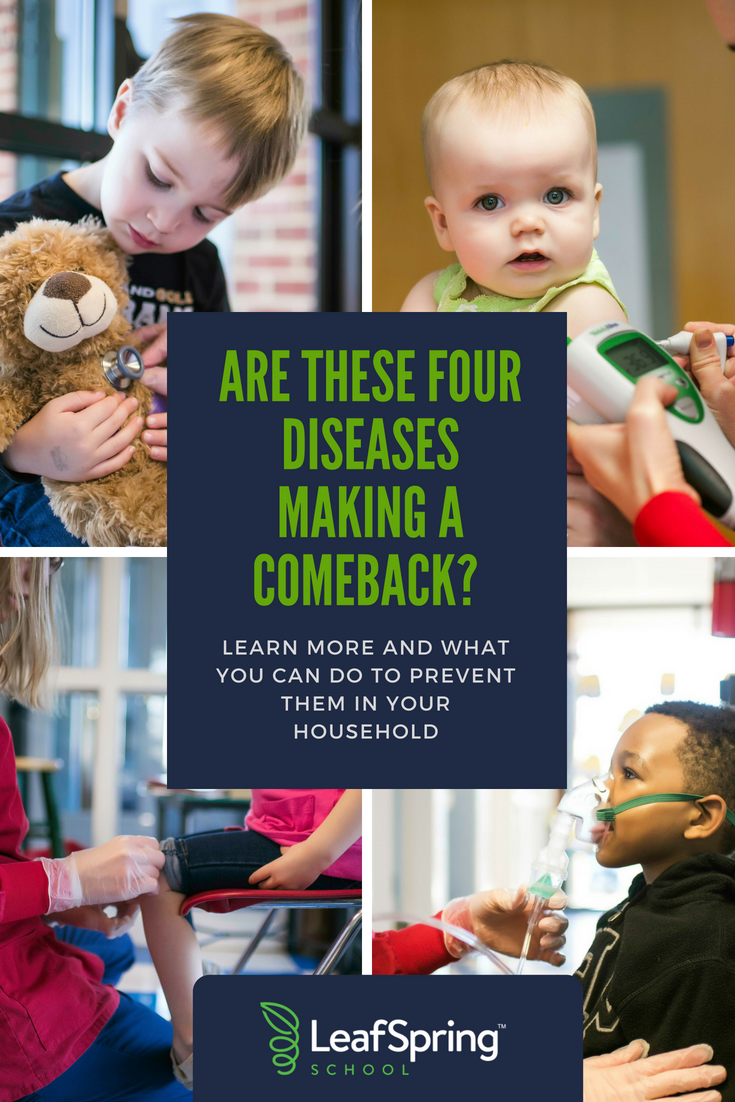Disease Comeback Stories – Are These 4 Diseases Making a Comeback?
Originally published in the August 2018 print and online version of Richmond Family Magazine
By Alison Soloman, R.N.
We don’t usually associate the phrase “history repeats itself” with illness, but sometimes diseases we thought were ancient history – or at least so uncommon they slide off the radar – make a sneaky comeback. Here’s a look at four diseases you might think were left in the past, but are actually popping up in children and adults across America.
Rickets: A disease characterized by soft and weak bones due to vitamin D deficiency, rickets was first recorded as an outbreak in England in the seventeenth century. It was caused by malnutrition, and in children, presented as bowed legs or knock knees.
Why is it making a comeback? Rickets has been virtually non-existent in the United States in the last several decades, but experts have noticed a reemergence of the disease in the past few years. While still rare, the comeback is due to the cultural shift of people spending more time indoors. Additionally, with more mothers exclusively breastfeeding, infants are more at risk since vitamin D is not abundant in breast milk.
How can you protect your family? Infants who are breastfed need a supplement of vitamin D and a little sunshine to keep their bones strong and healthy. In fact, we all need it, since nearly 75 percent of adults in America are deficient in vitamin D. (We also need sunscreen – and plenty of it. You can absorb vitamin D with sunscreen.)
Whooping Cough: A persistent, unrelenting cough that causes a gasping for air, or whoop, during the coughing fits, whooping cough is also known as pertussis and dates back to the Middle Ages. Pertussis got its nickname from its most prominent symptom, that whoop sound.
Why is it making a comeback? The vaccine was improved in the 1990s to make it safer with fewer side effects, but unfortunately, it was also less effective because the immunity to whooping cough didn’t last as long as it did with the older vaccine.
How can you protect your family? If you’ve ever heard the whoop sound coming from a little baby, it’s a sound you’ll never forget. It is very important for adults and teenagers who will be around infants (the most susceptible group to develop serious complications or death from whooping cough) to be revaccinated. This includes new parents, grandparents, babysitters, and childcare workers.
Scarlet Fever: This disease, which is similar in symptoms to strep throat, is a bacterial illness named after its very red, sandpaper rash, accompanied by a fever. Rampant in the Victorian Era, scarlet fever was often deadly to children, but when antibiotics became widely available, the disease was quickly extinguished.
Why is it coming back? Its comeback is stumping doctors and epidemiologists (scientists who study disease and public health). A current theory about its return is that the overuse of antibiotics has spawned a resistant bacteria, leading to an increased incidence of scarlet fever. In the United States, scarlet fever is not a reportable illness, so it is difficult to track.
How can you protect your family? There is no vaccine for scarlet fever, and once you have it, you can only treat the symptoms. However, you can keep your little ones free from this yucky illness by following the same rules you would for any contagious disease: wash hands frequently; stay away from people who are sick; and don’t share saliva with friends.
Mumps: A virus that causes fever and fatigue with swelling of the parotid glands (the salivary glands under your ears), causing cheeks to puff out, mumps may have affected moms and dads who are fifty-plus when they were children. Vaccination programs for mumps began in the United States in the late 1960s. Prior to that, outbreaks were common among children and adults living in close quarters.
Why is it coming back? Researchers are working on that. In the past few years, mumps outbreaks have increased, particularly among college students. According to the CDC, there were 229 cases reported in 2012 and 6,366 cases in 2016. Mumps can be transmitted via saliva, and 20 percent of people with the virus do not show any symptoms.
How can you protect your family? The best way to protect children and yourself from mumps is to have a completed and current MMR vaccination.
While it’s still incredibly rare for you and your family to develop any of these diseases, it’s important to remain up to date on vaccinations and practice healthy hand-washing – perhaps the most important well-family habit of all.
About Alison Soloman, R.N.
Alison Solomon, RN, is the nurse at the Get Well Place at LeafSpring School at Three Chopt, where she cares for mildly ill children, as well as children from the community who are too sick to go to their own school or childcare. She uses her sixteen years of nursing experience to consults with teachers and staff about healthy habits to teach children. She and her husband have three children and are also foster parents.

